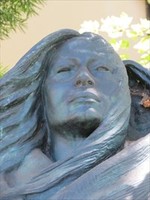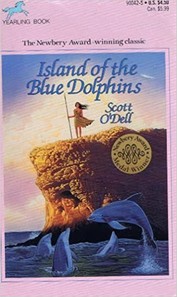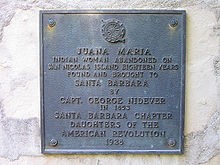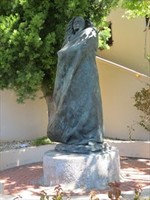Sacagawea Statue
Introduction
Text-to-speech Audio
Images
Sacagawea's Face

Scott O'Dell's Island of the Blue Dolphins

Possible Portrait of Juana Maria
.jpg)
Juana Maria Plaque Placed by the Daughters of the Revolution

Sacagawea Statue

Backstory and Context
Text-to-speech Audio
At the corner of the Chase Bank building in Santa Barbara, California, there is a statue of Shoshone woman Sacagawea and her infant son, who worked on the Lewis and Clark Expedition (1803-1806), she never came to Santa Barbara. For this reason and others, this statue is frequently mistaken for San Nicoleño Chumash woman, Juana Maria, mythologized in Scott O'Dell's Island of the Blue Dolphins (1960). We know that this statue is Sacagawea because it was in a series of casts made by artist Harry Jackson, whose signature, along with the cast signature and date is found at the base.
Santa Barbara was known as Syuxtun (Chumash for “it forks” or “where the two trails run”) before it was renamed after the Catholic martyr, Saint Barbara, by Sebastian Vizcaino in 1602. There is ample archaeological evidence that the Chumash lived on the Santa Barbara coast for at least 9,000 years. With this history, it follows that there would be a depiction of a Chumash woman in the downtown Santa Barbara area, except there is not. The statue is a mass-copied casting of Harry Jackson’s “Sacagewea” (1980), cast in bronze with patina and a concrete base. The artist’s signature at the base notes it is a cast, and other casts, which can be found at the Buffalo Bill Center of the West in Cody, Wyoming and in private collections.
However, it is unclear why Sacagewea (Shoshone for “Bird Woman”; also spelled Sacajewea, Shoshone for “Boat Launcher”) is outside of Chase Bank. She was not Chumash, nor did she ever visit Santa Barbara. She was a Lemhi Shoshone woman who led Lewis and Clark from the Mandan-Hidata villages in the Dakotas, across the Rocky Mountains to Oregon between 1804 to 1806 while pregnant and nursing. Sold into slavery by a Hidatsa raiding party in 1800, she was enslaved and bought by fur trader Toussaint Charbonneau, who made her one of his plural wives. When Meriwether Lewis and William Clark came to the Mandan-Hidatsa villages to hire a guide, they hired Charbonneau, who brought pregnant Sacagewea to communicate with the Shoshone to acquire horses. She provided life-saving information to Lewis and Clark, including the identification of edible plants, making moccasins and other clothing for winter, and calming suspicions of other indigenous groups they would come across with just her presence. Giving birth to her son Jean Baptiste and later daughter Lisette, she is believed to have died in 1812 near what is now known as Mobridge, South Dakota, though records are mixed.
Many visitors, before reading the statue’s rather faint plaque that states her name as Sacagewea, believe her to be Nicoleño Chumash Juana Maria, whose story was permanently mythologized in Scott O’Dell’s middle-grade classic chapter book, The Island of Blue Dolphins (1960). It is a fair assumption--Sacagewea was not Chumash and never came to California. It is not clear why she would be here; however, on the other hand, one indigenous woman should not so easily stand in for another. Nevertheless, the assumption is made, even though the statue clearly has a baby in tow, and we do not have records of Juana Maria ever having a baby (nor is it part of her mythology in the ways that it is part of Sacagewea’s).
Juana Maria was left alone on San Nicolas Island for eighteen years (1835-1853) after the Franciscan padres of the Santa Barbara Mission sought to remove all Nicoleño Chumash from the island San Nicolas Island. She was discovered by George Nidever, a Santa Barbara fur trapper, who had been paid by the padres to find her. It was reported that she had adjusted to life alone, eating seals and wild ducks and living in a house made of whale bones.
Juana Maria’s story does not end when she was found, where O’Dell’s telling does, though it was close to its end. When she was brought to Santa Barbara, the Chumash at the mission could not understand her language, nor could the Tongva, who resided on the southern Channel Islands. It was unclear if it was because she spoke a different dialect or if not having someone to talk to for so long made it difficult for her to speak. Newspapers reported that she conformed to no customs, enjoyed coffee and liquor, and sang most of the time. Because of the lack of resources to understand her, there is little written about her life other than other people’s reactions to her. Seven weeks after she left the island, she was quickly baptized and died of dysentery in Garey, California. She is buried in Nidever’s family plot in the Santa Barbara Mission.
Juana Maria’s story does not end with her death. In fact, it is at this point that her US-sensationalized public life begins. In 1928, the Daughters of the American Revolution placed a plaque commemorating her at the site of her burial on the Mission grounds. Most of Juana Maria’s personal possessions were part of collections and on display in the California Academy of Sciences, and they were destroyed in the 1906 San Francisco earthquake and fires.
In 1939, archaeologists found Juana Maria’s whale-bone hut on San Nicolas island, which matched the descriptions that Nidever provided when they returned to Santa Barbara. Further excavating has continued through the decades, leading to discoveries of Coast Redwood Nicoleño-styled boxes filled with what are believed to be 200 of Juana Maria’s possessions, including an abalone shell dishes and fish hooks, glass projectile points, and red ochre. An archeological discovery in 2012 is believed to be Juana Maria’s cave. Archaeological research has stopped at the request of the Pechanga Band of Luiseno Indians, who claim cultural affiliation with the island’s ancient residents.
The Island of the Blue Dolphins is still a regular part of the fourth grade curriculum, focusing on California history and the Mission system. Historical fiction like this is important to the imagination, understanding, and interest of history for children. But these works can only do so much, tell so much. O’Dell’s story only focuses on one aspect of her life: her solitude, being the last of her tribe, much like another children’s book, Theodora Kroeber’s Ishi: the Last of His Tribe (1964). Perhaps we could call this an aspect of imperialist nostalgia? It is not that Sacagewea should not be in Santa Barbara; it is that historically she was not. It certainly is not that we should not have indigenous representation whenever we can, but it should be intentional and in collaboration with the local indigenous community. Perhaps this is an extension of Santa Barbara’s larger built environment crafting, apparent in its Mediterranean and Spanish Revival Style architecture to create a sense of a Spanish and Californio Fantasy Past. With such a backdrop, Sacagewea or any incidental indigenous person as a statue is to be seen rather than understood. This is all to say, that more interpretation at this site would be very useful.
Sources
Blakemore, Erin. Stranded on the Island of the Blue Dolphins: The True Story of Juana Maria, JSTOR Daily. February 3rd 2016. Accessed April 15th 2021. https://daily.jstor.org/juana-maria-blue-dolphins/.
Buckley, Jay H. "Sacagawea": Native American Explorer, Accessed April 15th 2021. https://www.britannica.com/biography/Sacagawea .
California Islands Symposium 2012, Channel Islands, National Park Service. Accessed April 15th 2021. https://www.nps.gov/chis/learn/photosmultimedia/california-islands-symposium.htm.
McClure, Nancy. Sculpture Guide: Sacajawea, "Sacajawea" by Harry Jackson. August 18th 2015. Accessed April 15th 2021. https://centerofthewest.org/2015/08/18/sculpture-guide-sacajawea/.
